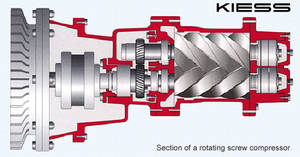6.4 Rotating screw compressor
The main components of the rotating screw compressor are two screw rotors within the case that encloses them firmly.
Here, the rotor tooth spaces form the compression volume.
Compression (without valves) is controlled via suction and pressure grooves at the ends of the case.
There are oil-free and oil-injected rotating screw compressors.
Rotating screw compressors with oil-free compression volumes (compressed air is completely oil-free) are designed for final pressures up to 3 b single-stage, for higher pressure values double-stage (multi-stage).
Oil-injected rotating screw compressors can reach a final pressure of up to 14 b at single-stage constructions. In order to be able to reach higher values of final pressure double-stage variants are used as well.
As regards oil-injected rotating screw compressors the oil is used for sealing, cooling and lubricating.
The control of the rotating screw compressor is carried out by intermittent duty control and idle speed control. The load stages full load and idle speed are always possible to run. As regards oil-injected machines control can be performed by drainage coil adjustment.
Furthermore, you can also get speed-controlled compressors that can be adjusted in such a way that the respectively required amount of air will always be available.
Apart from the prescribed safety valves further monitoring units normally exist, for instance the monitoring of compressor temperature, engine temperature, pressures, power consumption, etc.
If one of the fuses reacts during operation, the compressor unit will be usually switched off automatically.


Section of a rotating screw compressor

 Click to enlarge!
Click to enlarge!
Control system – under load
Click to enlarge!
Control system – at relief
Click to enlarge!
Rotating screw compressor (compression)
Click to enlarge!



